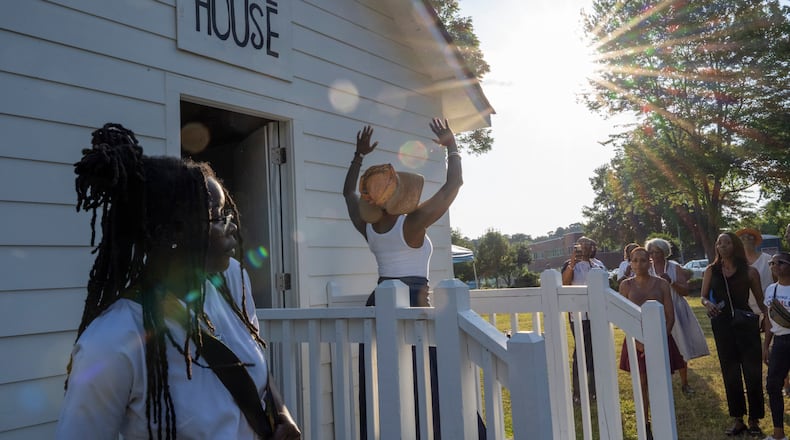This story was originally published by ArtsATL.
Past the bustle of Decatur Square, a small, white house sits in the middle of a green field. Just beyond the field, cars whip by a busy intersection. Located in the Beacon Hill neighborhood, the movable one-room house is part of artist and activist Charmaine Minniefield’s ongoing, multiyear Praise House Project. The public art installation re-creates the tradition of praise houses — structures built on plantations and used by enslaved people as places of prayer. There, they gathered in community to resist the erasure of their traditions and practice the “ring shout,” a full-bodied rhythmic movement involving call and response chants and stomping.
Credit: JULIE YARBROUGH
Credit: JULIE YARBROUGH
This scene took place on Juneteenth: At sunset, the exteriors of the house will be lit with projections playing outward in celebration. For now, Minniefield leans against the wooden doorway of the Praise House, peering out at Beacon Hill. She waves to passersby, beckons over the ones that pause on their walks. One man holds up his hand in solidarity. Minniefield is thrilled. “Happy Juneteenth!” she calls across the field. She says this sort of interaction is common; the house often receives visits from curious people driving or walking by.
Four months ago, the project was scheduled to be demolished at its previous location. But Minniefield wanted to maintain the house — and the memories and stories it held — and negotiate a move rather than a reconstruction. Raising the tens of thousands of dollars needed to save the house required ingenuity and grit — and, Minniefield says, the guiding spirit of the house itself.
The project was first presented at Oakland Cemetery in 2021 by Minniefield, with the support of Flux Projects and in cooperation with Emory University. There, it honored more than 800 unmarked graves in the African American Burial Grounds, a section in the northeast quadrant of the property that is legally separated from the rest of the public cemetery.
Minniefield’s artistic career as an artist, curator, producer and educator is helmed by her activism, and the Praise House is an exemplar of this. Her work draws from ancestral traditions in Africa and the diaspora, and she aims to uplift communities in the present while paying homage to and acknowledging the past.
The inside of the Praise House contains a multimedia projection and sound installation of a ring shout created from archives and images from the community in which it is placed. The house was on the Emory University campus from October 20 through December 15, 2023, and moved to Decatur on March 13, 2024, where it has remained for summer festivals and holidays, including the Pan African Festival. Its move to South-View Cemetery in September will acknowledge the 1906 Atlanta Race Massacre.
Credit: JULIE YARBROUGH
Credit: JULIE YARBROUGH
Inside, a song recalling the ring shout echoes through the belly of the house. Midway through the song, the gray and translucent projections become more opaque as they slink onto the floor, re-creating bodies moving in a circle. The song, “Rite to Freedom,” features vocals by soprano Malesha Jessie Taylor and blends hymn singing from the Black church tradition with contemporary Afro house and soulful house electronic dance music, showcasing the evolution but also interconnectedness of past and present. Integral to the piece is the consistent African drumming that marks the transitions and infuses power.
Minniefield joins in. She picks up her tambourine and plays it to the beat of the drum: the thread connecting the present to the past and ancestors.
“I’ve been saying the ring shout is a meditation and healing practice,” Minniefield says. “We don’t meditate in stillness; we meditate in motion. And I’ve been saying, our memories are medicine. And believing it, knowing it, in this location I’m experiencing it.”
Subsequent to the installation at Oakland Cemetery, Minniefield received a grant from the National Endowment for the Arts, designed to support presentation of the project at three locations across Atlanta with histories of Black erasure: Emory University, downtown Decatur and South-View Cemetery. While these funds were sufficient for mounting the project in each location, they did not cover the cost of moving the house.
Credit: JULIE YARBROUGH
Credit: JULIE YARBROUGH
The move to Beacon Hill from Emory was no easy task. Moving, as opposed to dismantling the house, cost $150,000. While the project received a $30,000 grant from the National Endowment for the Arts and $10,000 from Emory, Minniefield turned to fundraising, including an entreaty to DeKalb County CEO Michael Thurmond’s office, to raise the remaining $65,000. The weekend before the scheduled demolition of the Praise House, Minniefield was still making calls with bated breath and crossed fingers — to donors, local foundations and municipal partners. Finally, on the very last night, she received a call from a donor who promised $50,000.
It was a miracle, she says, but more than that, it was an action led by the house. “We relived the memory of moving a Praise House. The ancestors are literally leading us through their actual memories. The Praise House has its own memories, and its own will, and it will move when it wants to move.”
Minniefield found herself navigating echoes of previous struggles. “I have had to face my fears and stand in my worth at every moment of this project. And sometimes that has been in the face of white supremacy. I’ve had to stand there and say we’re worth defending, or I can do this, I can build this, I can get a national fellowship, when, structurally and systematically, those I was speaking to did not believe me. And, eventually, I got folks in alignment, and the blessings, openings, transformations — all of that eventually took place.”
The new location, Beacon Hill, was historically a freedmen’s town, built by formerly enslaved people after the Civil War and home to historic churches, homes, businesses and schools. In the 1930s, the city of Decatur began creating public housing in the area, causing displacement among Black residents.
“They took the land of the people that lived here, where they had used their earnings to buy the land at emancipation,” Minniefield says. “Now they had to pay rent and live under restricted ordinances on that land. For me, Beacon Hill is this story of resilience and enduring love, and excellence and achievement in every way.”
Credit: JULIE YARBROUGH
Credit: JULIE YARBROUGH
After an intense journey, the house remains intact, and centers a new community.
Minniefield views the project as a social experiment. Although using religious language, the work aims to be secular and universal. The uniting thread is a common invitation to remember our histories and ancestral traditions in order to look forward.
“I think that the act of gathering is magical. And there is an intention that each person comes with that is connected to the whole, that is transformational, to create community, right in the moment. You know — total strangers. I think that is really very powerful,” Minniefield says.
Outside, the gathered crowd forms its own kind of praise house. As the sun goes down, we exchange names and share stories. A child blocks the projector by accident, creating a shadow against a wall of the house. Her mother rushes toward her, but Minniefield laughs. “I want her to be a part of it!”
::
Mitali Singh is a writer living in Atlanta.
Credit: ArtsATL
Credit: ArtsATL
MEET OUR PARTNER
ArtsATL (artsatl.org) is a nonprofit organization that plays a critical role in educating and informing audiences about metro Atlanta’s arts and culture. ArtsATL, founded in 2009, helps build a sustainable arts community contributing to the economic and cultural health of the city.
If you have any questions about this partnership or others, please contact Senior Manager of Partnerships Nicole Williams at nicole.williams@ajc.com.
About the Author
Keep Reading
The Latest
Featured







